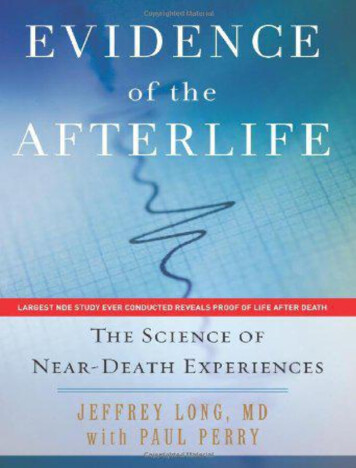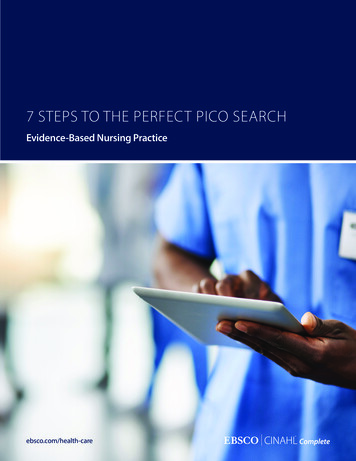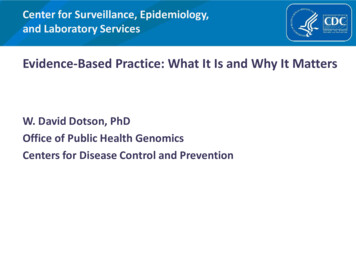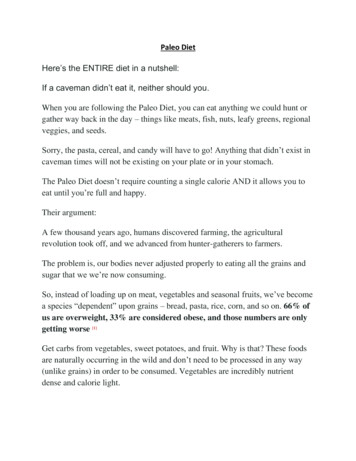
Transcription
EVIDENCE CLIPThe Popular Paleo DietNovember 2014Topic OverviewThe Paleo diet is very trendy right now. Youmay see it on menus, in popular books, manyblogs, websites and cookbooks or hear it talkedabout just about everywhere. This diet is alsoreferred to as the Paleolithic, caveman, StoneAge and the hunter-gatherer diet.The Premises of the Paleo DietThis diet attempts to duplicate the diet of earlyhumans. It is based on the idea that humangenetics have not changed or evolved over thepast 10,000 years, since the time before theuse of agriculture and so we are better adaptedto the diet and lifestyle of the Paleo period thannow. Additionally, anthropological studiessuggest little to no evidence of today’sprevalent chronic diseases (cardiovasculardisease, diabetes and obesity) as well as dentalcavities, joint disorders and acne in our Paleoancestors, despite often consuming a highmeat diet.The Paleo diet promotes predominantly meat,fish, vegetables and fruit, and nuts, while foodsthat come from agriculture, including all grains,dairy foods, sugar, salt and low nutrientprocessed foods are to be avoided, since theywere not consumed by Paleo people (1).Legumes are considered “toxic” by the Paleoproponents since raw beans contain antinutrients such as lectin. The macronutrientbreakdown of the Paleo diet is promoted to be19-35%protein,34-45%carbohydrate,without a specified amount of fat (1).Strengths of the Paleo Diet Fats are not as bad as once thought,and consuming omega 3-rich foods is of particular importance (2).Nuts are also valuable sources ofdesirable fats, vitamins, minerals andphytochemicals. Research suggests thatnut consumption is associated withdecreased LDL cholesterol (3) and alower incidence of fatal and non-fatalischemic heart disease (4).Vegetables and fruit, especially darkgreen, are very nutritious.Evidence AnalysisChallenges with the Paleo PremisesThe evidence is contradictory in the efficacy ofthe Paleo diet. Three randomized controlledtrials have been conducted on the Paleo diet(5-7). All three studies examined the Paleo dietin participants who were either obese, had type2 diabetes, or glucose intolerance. The controlgroups in these studies were instructed tofollow a Mediterranean-like diet (5), a diabeticdiet (6) or a low fat/high fibre diet (7). None ofthe purported benefits of the Paleo diet s, which was observed among theparticipants instructed to follow the Paleo dietin two of the studies (6,7).In contrast, there is evidence that a highprotein, low fat, moderate carbohydrate weightcontrol diet can produce weight loss amongobese subjects and also a significant reductionin serum triglycerides, even though it includesdairy foods and whole grains (8).While two studies of the Paleo diet showedgreater weight loss in the short term (three tosix months) compared to the diabetic (6) andlow fat/high fibre (7) diets, the weight loss 2014 Dietitians of Canada. All rights reserved.May be reproduced for educational purposes.PAGE 1
Evidence Clipdifferential was not maintained relative to thelatter diet at two years (7), and the Paleo dietwas not superior to the Mediterranean-like dietfor weight loss (6). There was no significantdifference in body fat loss on the Paleo dietcompared to either the Mediterranean-like dietat three months (5) or the low fat/high fibredietattwoyears(7).Whilewaistcircumference was lower among the people onthe Paleo diet at three months compared to theMediterranean-like (5) and diabetic (6) dietsand at six months for the low fat/high fibrediet, the latter difference was not maintained attwo years (7).Participants on the Paleo diet did not havesuperiorLDLcholesterol,systolicbloodpressure or C-reactive protein levels (a markerof inflammation) (6,7). Inconsistent resultswere seen for the Paleo diet regarding whetherit was superior regarding glucose tolerance (57), or HDL cholesterol (6,7), or diastolic bloodpressure (6,7).Two secondary analyses of the Paleo dietassessed whether satiety was greater on thePaleo diet compared to the Mediterranean-likeand diabetic diets (9,10). One of these studiesfound that compared to a diabetic diet,subjects eating a Paleo diet reported asignificantly higher Satiety Quotient perreported calorie consumed (9). Compared to aMediterranean-like diet, people on a Paleo dietdid not report a significant difference in SatietyQuotient per calorie, until the researchers didan additional analysis based on the means(10). Basing this additional calculation on themeans would lower the standard deviationsthus increasing the chances of finding astatistically significant result (11), so this is nota valid statistical analysis.AdditionalPremises ChallengeswiththePaleoThe reasons ancient people may havehad lower rates of chronic diseasesassociated with plenty of food are thatthey had to work hard at collectingenough food to survive, and they hadshorter life expectancies than today(12).There likely was some obesity in thePaleolithic era, since many of thestatues were of obese women (13).Humans have evolved on myriaddifferentdiets,withvaryingcomposition, depending on their location(14), but a common thread untilrecently was that their diet was basedon whole foods without added sugars,fats and salt.Are Legumes Really Toxic?Cordain dictates that legumes (includingpeanuts and soy) are “toxic” since raw orundercooked beans induce “nausea, vomiting,abdominal pain, and severe diarrhea” (14). Anadditional reason he recommends avoidingthem, is that legumes “are nutritionallightweights when compared to meat, fish andother animal foods” (15).Raw or undercooked beans (such as thosecooked in slow cookers that do not reach 100degrees Celsius (16) can temporarily triggerthese symptoms due to their content of alectin, known as phytohaemaglutanin (PHA)(17,18). It is important to note that, soakingdecreases the lectin content of beans (19) andensures that subsequent boiling can completelyeliminate the lectins in only 10 minutes(16,18). Germinating beans reduces their lectincontent, one study reported a decrease of25%, but it does not eliminate lectin (20).Thus, the standard way in which humanstypically consume beans drastically reduces oreliminates the lectin content. 2014 Dietitians of Canada. All rights reserved.May be reproduced for educational purposes.PAGE 2
Evidence ClipLegumes are a dietary staple in manytraditional cultures in Latin America, Africa, andAsia without indications of toxicity (21).Legume consumption has been associated withhealth benefits and better nutrition intakes.People who eat beans have higher intakes offibre,folate,potassium,phosphorus,magnesium, iron and zinc than individuals whorarely or never consume legumes (22). Asystematic review of five observational cohortstudies found that legume consumption (4 x100 gram servings per week) was associatedwith a 14% lower rate of ischemic heartdisease (RR 0.86; CI 0.78 to 0.94) (4).However, these observational studies did notfind an association between legume eating withany difference in the risk of stroke or type 2diabetes (4).Systematic reviews have been performed onrandomized controlled trials to evaluate theeffect of legumes on several health and weightoutcomes. Intakes of about 130 grams oflegumes per day reduces LDL cholesterol levelsby 0.17 mmol/ (95% CI, 0.25 to 0.09 mmol/L)(23). Another systematic review found thatlegumes significantly lowered systolic (-2.25mm Hg; 95% CI, -4.22 to -0.28, P 0.03) butnot diastolic BP (-0.71 mm Hg; 95% CI, -1.74to 0.31, P 0.17) (24). Although the use ofgreen beans (Phaseolus vulgaris) was notassociated with a significant difference inweight loss compared to a placebo in asystematic review of randomized controlledtrials (-1.77 kg, 95% CI, -3.33 to 0.33, P 0.10), these beans were helpful in terms of asignificant loss of body fat (-1.86 kg; 95% CI, 3.39 to -0.32, P 0.02) (25). Of importance,legume consumption reduces oxidative stressmarkers, the pro-inflammatory marker Creactive protein, as well as improves LDLcholesterol levels and systolic blood pressure inoverweight subjects (26,27).What About Dairy?The Paleo diet excludes dairy for five reasons,which have limits to their validity:1. “Until the dawn of agriculture 10,000 yearsago and the subsequent domestication ofdairy animals, milk, butter, cheese andyogurt were never part of our ancestors’menu (28).” However, several European,African, and Middle Eastern populationshave evolved to tolerate lactose (29),suggesting that many populations haveevolved their capacity to digest dietarycomponents, which contradicts a primarypremise of the Paleo diet.2. Milk is net-acid producing (28). However,milk is not net-acid producing as measuredby the two methods used to define acidexcretion, i.e. net-acid excretion and acidpH (30).3. Dairy products produce a high insulinresponse, despite modest glycemic effect(28). However, dairy products are alsotrophic to muscle growth, which isconsidered desirable (31).4. Milk may be a trigger for acne as part ceisfromobservationalstudies.Doubleblindrandomized trials are needed before acausal relationship is assumed.5. North Americans have some of the highestcalcium intake in the world, but also someof the highest rates of osteoporosis (28).However, this is not true, and is an ecologicfallacy, which is the “bias that may occurbecause an association observed betweenvariables on an aggregate level does notnecessarily represent the association thatexists at an individual level” (32). Anotherimportant fallacy is that osteoporosisfracture risk is lower among Asianpopulations,sinceoverallfractureprevalence rates are similar betweenurbanized Asians and Caucasians (33), andvertebral fractures rates are actually higheramong Asians (34). There are considerable 2014 Dietitians of Canada. All rights reserved.May be reproduced for educational purposes.PAGE 3
Evidence Clipdifferences in osteoporosis fracture ratesamong urbanized versus rural Asians, whichis assumed to be at least in part due todifferences in physical activity levels (33).Are Grains Really So Unhealthy?Proponents of the Paleo diet claim that grainsshould not be consumed because of healthrisks, because they are net-acid producing,lower in nutrients by weight than vegetablesand fruit, and humans did not evolve eatingthese foods.The health risks the Paleo proponents areconcerned about for grains include highglycemic and insulin responses, inflammationpromotion, and thus CVD, type 2 diabetes andcancer risk. However, the glycemic and insulinresponses depend on individuals’ glucosetolerance (7) and varies across grain foods andwhich foods are consumed with the grains (35).There is evidence that shows that early humansdid consume some starch-containing foods, andmay have consumed grains as long ago as30,000 years (36-38).Although health benefits have not beenassociated with refined grain foods, a diet highin whole grains is associated with lower bodymass index, smaller waist circumference, andreduced risk of being overweight (39).In terms of the claim that grains are net-acidproducing, no studies have evaluated net-acidexcretion after grain consumption, and acritical examination of the acid-ash hypothesisshows it does not stand up under scrutiny (40).Other Points about the Paleo Diet Is a Paleo diet expensive? No studieswere found that that examined thePaleo diet in terms of food costs, butone computer analysis study examined thefeasibilityofconsuminganutritionally adequate Paleo diet given alimited budget (41). Metzger, et al.found that an almost nutritionallyadequate Paleo diet could be achieved;except for calcium, iron and fibre; if thefollowing quantities of food wereconsumed daily: poultry 399 g, eggs 45g, low cost fish 75 g, potatoes 909 g,dark green vegetables 110 g, othervegetables 134 g (41). This study raisesthe question – if a computer couldalmost create a nutritious diet givenlimited funds, can consumers?The Paleo diet as defined today likelydoes not reflect actual ancient eatingpatterns. For example, individuals in thePaleo period likely ate insects (42),marrow and organ meats (43) for theirimportant nutrient contributions, andlived with feast and famine.The premise of the Paleo diet opposesother known healthful diets, such as thevegetarian diet.Early humans reportedly ate manydifferent diets, ranging substantially incomposition and macronutrient content)depending on where they lived (14).The ancient forms of many of our foods,before plant breeding to improvepalatability and yields, were lessnutritious, less tasty, and are impossibleto obtain now (43).The Paleo diet is the latest diet to be claimed tosupport weight loss and optimal health. Testingof whether this diet has advantages has onlybegun.While it is possible to choose nutritionallyadequate diets while adhering to the Paleo dietit requires careful food selection to ensurenutritional adequacy. The Paleo diet is mostlimiting for fibre and calcium, and surprisingly,iron (41) and most likely vitamin D. This diet is 2014 Dietitians of Canada. All rights reserved.May be reproduced for educational purposes.PAGE 4
Evidence Clipdriven, not by nutrition science, but by flawedinterpretations of anthropology (43) andopinion. The randomized trials reveal that thePaleo diet is not a magical solution to weightcontrol or health concerns (5-7).A superior diet? Most people’s diets would likelyimprove with less processed foods/addedsugars/refined grains, especially if thosecalories are replaced with vegetables, asadvocated in the Paleo diet (45). However, therandomized trials on this diet revealed thattheir reported protein intakes (6,7), andnitrogen excretion (7) were not higher in thePaleo groups compared to the control dietgroups, despite the higher protein intakeadvocated by the Paleo diet. These findingssuggest that the Paleo diet may be hard toadhere to (7), and the diet may not appeal toall people (5). If people find it hard to complywith the diet, attempting to follow it could leadto feelings of failure.Many of the health problems of modern societyare likely to be related to the sedentary natureof modern lifestyles (46,47) combined withgenerous consumption of energy, rather thanthe distribution of food across food groups.So far, there have been only three randomized,controlled trials of the Paleo diet (5-7), andthere is a need for more trials to fullyunderstand the potential effects of this diet.These RCTs have been conducted amongpeople with metabolic syndrome. If healthynon-obese subjects are consuming this diet, itwould be very advantageous to have studiesamong these people.ancestors but there is evidence that they atesome grains and legumes (36-38). It isimportant to consider that humans haveevolved since the advent of agriculture and theconsumption of dairy foods, as severalpopulations have evolved to tolerate lactose(29). Thus, the Paleo diet is not a miracle dietand several of the premises of the Paleo dietare not supported by evidence.Written by Tanis Fenton PhD, RD, FDC.Reviewed by Jennifer Sygo RD, MSc; BethArmour MEd, PDt; Jayne Thirsk PhD, FDC, RD;and Warren Wilson PhD, Anthropologist.References1. Cordain L. The paleo diet. 2014 [cited 2014 Nov2.3.4.5.The Bottom LineThe Paleo diet does not provide exceptionalresults in terms of weight loss or healthadvantages (5-7). Little is known about whatactual foods were eaten by our Paleolithic6.26]. Available e/Flock MR, Harris WS, Kris-Etherton PM. Longchain omega-3 fatty acids: time to establish adietary reference intake. Nutr Rev. 2013Oct;71(10):692-707. doi: 10.1111/nure.12071.Abstract available baté J, Oda K, Ros E. Nut consumption andblood lipid levels: a pooled analysis of 25intervention trials. Arch Intern Med. 2010May;170(9):821-7. Abstract available shin A, Micha R, Khatibzadeh S, Mozaffarian D.Consumption of nuts and legumes and risk ofincident ischemic heart disease, stroke, anddiabetes: a systematic review and metaanalysis. Am J Clin Nutr. 2014 Jun;100(1):27888. Abstract available ndeberg S, Jönsson T, Granfeldt Y, BorgstrandE, Soffman J, Sjöström K, et al. A palaeolithicdiet improves glucose tolerance more than aMediterranean-like diet in individuals withischaemic heart disease. Diabetologia. 2007Sep;50(9):1795-807. Abstract available �nsson T, Granfeldt Y, Ahrén B, Branell UC,Pålsson G, Hansson A, et al. Beneficial effects ofa Paleolithic diet on cardiovascular risk factors intype 2 diabetes: a randomized cross-over pilot 2014 Dietitians of Canada. All rights reserved.May be reproduced for educational purposes.PAGE 5
Evidence Clip7.8.9.10.11.12.13.14.study. Cardiovasc Diabetol. 2009 Jul;8:35. doi:10.1186/1475-2840-8-35. Abstract available llberg C, Sandberg S, Ryberg M, Eriksson M,Brage S, Larsson C, et al. Long-term effects of aPalaeolithic-type diet in obese postmenopausalwomen: a 2-year randomized trial. Eur J ClinNutr. 2014 Mar;68(3):350-7. Abstract 4473459Noakes M, Keogh JB, Foster PR, Clifton PM.Effect of an energy-restricted, high-protein, lowfat diet relative to a conventional highcarbohydrate, low-fat diet on weight loss, bodycomposition, nutritional status, and markers ofcardiovascular health in obese women. Am J ClinNutr. 2005 Jun;81(6):1298-306. Abstractavailable nsson T, Granfeldt Y, Lindeberg S, HallbergAC. Subjective satiety and other experiences ofa Paleolithic diet compared to a diabetes diet inpatients with type 2 diabetes. Nutr J. 2013Jul;12:105. doi: 10.1186/1475-2891-12-105.Abstract available nsson T, Granfeldt Y, Erlanson-Albertsson C,Ahrén B, Lindeberg S. A paleolithic diet is moresatiating per calorie than a mediterranean-likediet in individuals with ischemic heart disease.Nutr Metab (Lond). 2010 Nov;7:85. doi:10.1186/1743-7075-7-85. Abstract 118562Bluman AG, Mayer JG. The Normal Distribution.In: Elementary statistics. Toronto: McGraw-Hill;2008. p. 271.Nerlich AG, Rohrbach H, Bachmeier B, Zink A.Malignant tumors in two ancient populations: anapproach to historical tumor epidemiology. OncolRep. 2006 Jul;16(1):197-202. Abstract 6786146Jozsa LG. Obesity in the paleolithic era.Hormones (Athens). 2011 Jul-Sep;10(3):241-4.Abstract available bbons A. "The Evolution of Diet". NationalGeographic. Sep 2014 [cited 2014 Nov 26].Available dain L. The paleo diet. Beans and legumes:are they paleo? [cited 2014 Nov 26]. Availablefrom: paleo/Grant G, More LJ, McKenzie NH, Pusztai A. Theeffect of heating on the haemagglutinatingactivity and nutritional properties of bean(Phaseolus vulgaris) seeds. J Sci Food Agric.1982;33(12):1324-6. Abstract available house JC, Haugh CA, Roberts D, Gilbert RJ.Red kidney bean poisoning in the UK: ananalysis of 50 suspected incidents between 1976and 1989. Epidemiol Infect. 1990Dec;105(3):485-91. Abstract available h ND, Bender AE, Reaidi GB, Gilbert RJ. Foodpoisoning from raw red kidney beans. Br Med J.1980 Jul 19;281(6234):236-7. Abstract 7407532Adeparusi EO. Effect of processing on thenutrients and anti-nutrients of lima bean(Phaseolus lunatus L.) flour. Nahrung. 2001Apr;45(2):94-6. Abstract available -Adawy TA. Nutritional composition andantinutritional factors of chickpeas (Cicerarietinum L.) undergoing different cookingmethods and germination. Plant Foods HumNutr. 2002 Winter;57(1):83-97. Abstractavailable uchenak M, Lamri-Senhadji M. Nutritionalquality of legumes, and their role incardiometabolic risk prevention: a review. J MedFood. 2013 Mar;16(3):185-98. Abstractavailable dryj AN, Yu N, Hartman TJ, Mitchell DC,Lawrence FR, Aukema HM. Pulse consumption inCanadian adults influences nutrient intakes. Br JNutr. 2012 Aug;108(Suppl 1):S27-36. Abstractavailable from:http://www.ncbi.nlm.nih.gov/pubmed/22916812Ha V, Sievenpiper JL, de Souza RJ, Jayalath VH,Mirrahimi A, Agarwal A, et al. Effect of dietarypulse intake on established therapeutic lipidtargets for cardiovascular risk reduction: a 2014 Dietitians of Canada. All rights reserved.May be reproduced for educational purposes.PAGE 6
Evidence Clip24.25.26.27.28.29.30.31.systematic review and meta-analysis ofrandomized controlled trials. CMAJ. 2014May;186(8):E252-62. doi:10.1503/cmaj.131727. Abstract available yalath VH, de Souza RJ, Sievenpiper JL, Ha V,Chiavaroli L, Mirrahimi A, et al. Effect of dietarypulses on blood pressure: a systematic reviewand meta-analysis of controlled feeding trials.Am J Hypertens. 2014 Jan;27(1):56-64. Abstractavailable akpoya I, Aldaas S, Terry R, Ernst E. Theefficacy of Phaseolus vulgaris as a weight-losssupplement: a systematic review and metaanalysis of randomised clinical trials. Br J Nutr.2011 Jul;106(2):196-202. Abstract 2844674Crujeiras AB, Parra D, Abete I, Martínez JA. Ahypocaloric diet enriched in legumes specificallymitigates lipid peroxidation in obese subjects.Free Radic Res. 2007 Apr;41(4):498-506.Abstract available rmsdorff HH, Zulet MÁ, Abete I, Martínez JA.A legume-based hypocaloric diet reducesproinflammatory status and improves metabolicfeatures in overweight/obese subjects. Eur JNutr. 2011 Feb;50(1):61-9. Abstract 0499072Cordain L. The paleo diet. Dairy: milking it for allit's worth. [cited 2014 Nov 26]. Available rüttli A, Bouwman A, Akgül G, Della Casa P,Rühli F, Warinner C. Ancient DNA analysisreveals high frequency of European lactasepersistence allele (T-13910) in medieval centralEurope. PLoS One. 2014 Jan;9(1):e86251. doi:10.1371/journal.pone.0086251. Abstractavailable aney RP, Rafferty K. Carbonated beveragesand urinary calcium excretion. Am J Clin Nutr.2001 Sep;74(3):343-7. Abstract available rtman JW, Tang JE, Wilkinson SB, TarnopolskyMA, Lawrence RL, Fullerton AV, et al.Consumption of fat-free fluid milk afterresistance exercise promotes greater lean mass32.33.34.35.36.37.38.39.accretion than does consumption of soy orcarbohydrate in young, novice, maleweightlifters. Am J Clin Nutr. 2007Aug;86(2):373-81. Abstract available st JM. A dictionary of epidemiology. 4th ed.Oxford: Oxford University Press; 2001.Kung AW, Lee KK, Ho AY, Tang G, Luk KD. Tenyear risk of osteoporotic fractures inpostmenopausal Chinese women according toclinical risk factors and BMD T-scores: aprospective study. J Bone Miner Res. 2007Jul;22(7):1080-7. Abstract available w CH, Cheung E, Cheung CL, Xiao SM, LoongC, Soong C, et al. Ethnic difference of clinicalvertebral fracture risk. Osteoporos Int. 2012Mar;23(3):879-85. doi: 10.1007/s00198-0111627-9. Abstract available nn BJ, Green TJ. Glycemic index and glycemicload: measurement issues and their effect ondiet-disease relationships. Eur J Clin Nutr. 2007Dec;61(Suppl 1):S122-31. Abstract 7992183Hardy K, Buckley S, Collins MJ, Estalrrich A,Brothwell D, Copeland L, et al. Neanderthalmedics? Evidence for food, cooking, andmedicinal plants entrapped in dental calculus.Naturwissenschaften. 2012 Aug;99(8):617-26.doi: 10.1007/s00114-012-0942-0. Abstractavailable nry AG, Brooks AS, Piperno DR. Microfossils incalculus demonstrate consumption of plants andcooked foods in Neanderthal diets (Shanidar III,Iraq; Spy I and II, Belgium). Proc Natl Acad SciU S A. 2011 Jan;108(2):486-91. doi:10.1073/pnas.1016868108. Abstract 1187393Revedin A, Aranguren B, Becattini R, Longo L,Marconi E, Lippi MM, et al. Thirty thousand-yearold evidence of plant food processing. Proc NatlAcad Sci U S A. 2010 Nov;107(44):18815-9.doi: 10.1073/pnas.1006993107. Abstractavailable lliams PG, Grafenauer SJ, O'Shea JE. Cerealgrains, legumes, and weight management: a 2014 Dietitians of Canada. All rights reserved.May be reproduced for educational purposes.PAGE 7
Evidence Clip40.41.42.43.44.45.46.47.comprehensive review of the scientific evidence.Nutr Rev. 2008 Apr;66(4):171-82. Abstractavailable nton TR, Tough SC, Lyon AW, Eliasziw M,Hanley DA. Causal assessment of dietary acidload and bone disease: a systematic review &meta-analysis applying Hill's epidemiologiccriteria for causality. Nutr J. 2011 Apr 30;10:41.doi: 10.1186/1475-2891-10-41. Abstractavailable tzgar M, Rideout TC, Fontes-Villalba M,Kuipers RS. The feasibility of a Paleolithic diet forlow-income consumers. Nutr Res. 2011Jun;31(6):444-51. Abstract available snik JJ. Termites in the hominin diet: a metaanalysis of termite genera, species and castes asa dietary supplement for South African robustaustralopithecines. J Hum Evol. 2014 Jun;71:94104. doi: 10.1016/j.nutres.2011.05.008.Abstract available rinner C. Debunking the paleo diet: ChristinaWarinner at TEDxOU. 2013 Feb [cited 2014 Nov26]. Available aleo-Diet-ChristLeonard WR. Food for Thought: Dietary changewas a driving force in human evolution. ScientificAmerican Inc. 2002 [cited 2014 Nov 26].Available ciamdieta.pdfCordain L. The paleo diet. The paleo diet faq.[cited 2014 Nov 26]. Available ova AP. The environment and healthcondition of the upper palaeolithic sunghirpeople of Russia. J Physiol Anthropol ApplHuman Sci. 2005 Jul;24(4):413-8. Abstractavailable yes M, Chustek M, Heshka S, Wang Z,Pietrobelli A, Heymsfield SB. Low physicalactivity levels of modern Homo sapiens amongfree-ranging mammals. Int J Obes (Lond). 2005Jan;29(1):151-6. Abstract available from:http://www.ncbi.nlm.nih.gov/pubmed/15534614 2014 Dietitians of Canada. All rights reserved.May be reproduced for educational purposes.PAGE 8
the Paleo diet. Three randomized controlled trials have been conducted on the Paleo diet (5-7). All three studies examined the Paleo diet in participants who were either obese, had type 2 diabetes, or glucose intolerance. The control groups in these studies were instructed to follow a

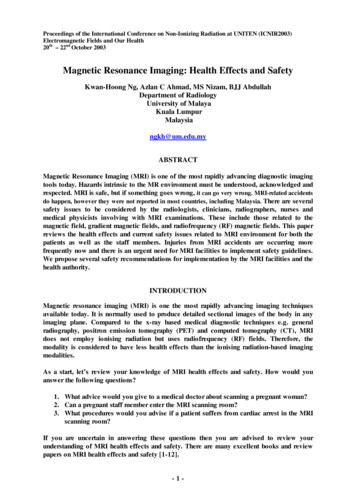
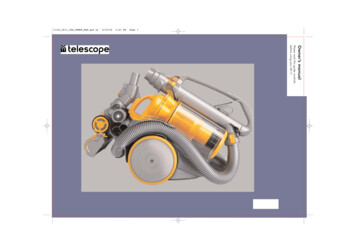



![project2 Encase.pptx [Read-Only]](/img/12/project2-encase.jpg)
